Those in search of special Greek islands might turn their attention to Chios. Located in the far east of the Aegean Sea, near the Turkish peninsula of Cesme, Chios is a hidden gem that can turn into a wonderful holiday destination.
I was in Chios many years ago, when the island didn’t have all the tourist attractions it has today. Back then, it had an incredibly peaceful atmosphere, exuding a kind of nostalgia for the 60s, when time flowed at a different, much more leisurely pace. I still remember the bland looks of the old men playing backgammon outside a taverna in the port of the capital Chios, who would not have been disturbed except, perhaps, by pouring another shot of mastika, the drink that defines this island with its rich history and authentic culture, into their glasses. Incidentally, that was the first time I drank mastic, the spirit made from the resin of the mastic tree, one typical of the Mediterranean area, whose name would translate as “chewing.”
Chios is Greece’s fifth largest island and has been blessed by the gods with gorgeous beaches on the east and west coasts, sweeping valleys, and mountains for hiking enthusiasts (Pelanio is the highest peak – 1,297m), deep caves for adventurers, and magical gorges carved by fast-flowing rivers. Apart from its natural beauty, Chios is a place where Greek history ‘tells’ stories from as far back as the Neolithic, pigmented with impressive monuments, among which the UNESCO World Heritage Monastery of Nea Moni shines. The island of Chios is also believed to have been the birthplace of the great ancient poet Homer.

We will therefore explore the island, highlighting the most beautiful tourist attractions of Chios, as well as the most beautiful beaches of Chios, for those considering and planning a holiday in this wonderful place.
Do you plan a vacation in Chios? Here are the best hotels in Chios!
- History of Chios Island
- How to get to Chios
- Where to stay in Chios
- Tourist attractions in Chios
- Map with the main tourist attractions in Chios and the best beaches in Chios (zoom for details)
- Daskalopetra, Homer’s Rock
- The caves of Chios
- Nea Moni Monastery
- The mastic villages of Chios
- The medieval castle of Chios
- Volissos Castle
- Kambos
- Chios Town
- The most beautiful beaches of Chios
- Mavra Volia Beach
- Karfas Beach
- Didima Beach
- Glari Beach
- Agia Fotini Beach
- Trahili Beach
- Megas Limnionas Beach
- Gastronomy in Chios
History of Chios Island
According to legend, the first king of Chios was Inopion, son of Dionysus and Ariadne, who came from Crete and taught the locals how to grow vines. The name Chios comes from Chiona, who was Inopion’s daughter, although another variant says that the place was named after Hios, son of Neptune, at whose birth too much snow (hioni) fell on the island. There is also a third variant, according to which the Phoenicians gave the island its name, the Syrian word for mastic being cios.
Archaeological finds reveal that the island was inhabited as early as 6000 BC. There is evidence that Chios was settled by the Ionians around 1100 BC, after which the island began to play a very important role in the area, including being famous for the wine it produced. But also for the flourishing of the arts, which led to the establishment of a famous school of sculpture and included the alleged birth of Homer, who is said to have lived on Chios sometime in the 8th century BC.
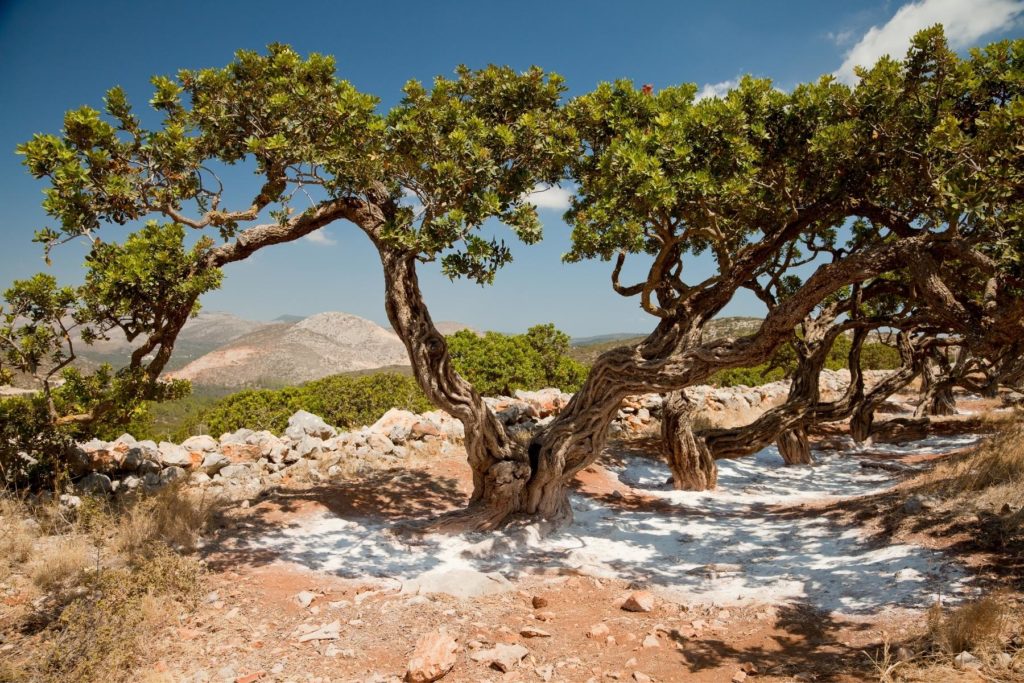
In 493 BC, the Persians ended the Ionian period, destroying the towns and vineyards. The locals then managed to escape Persian rule; the city was rebuilt and regained its notoriety, becoming a maritime force and a very important wine producer. Thucydides himself, the Athenian historian and general who described the Peloponnesian War so well, mentioned that the inhabitants of Chios were among the wealthiest Greeks.
Conquered by the Romans after the reign of Alexander the Great, Chios entered a period of decline. After the fall of the Roman Empire, it came under the occupation of the Byzantine Empire; in the 14th century, the island was conquered by the Venetians and then by the Genovese. This was the period when the mastic trade flourished, fortified villages were built, and the Turks were kept at bay until 1566. Christopher Columbus himself is said to have lived in Chios for two years during this period (some even claim he was born here).
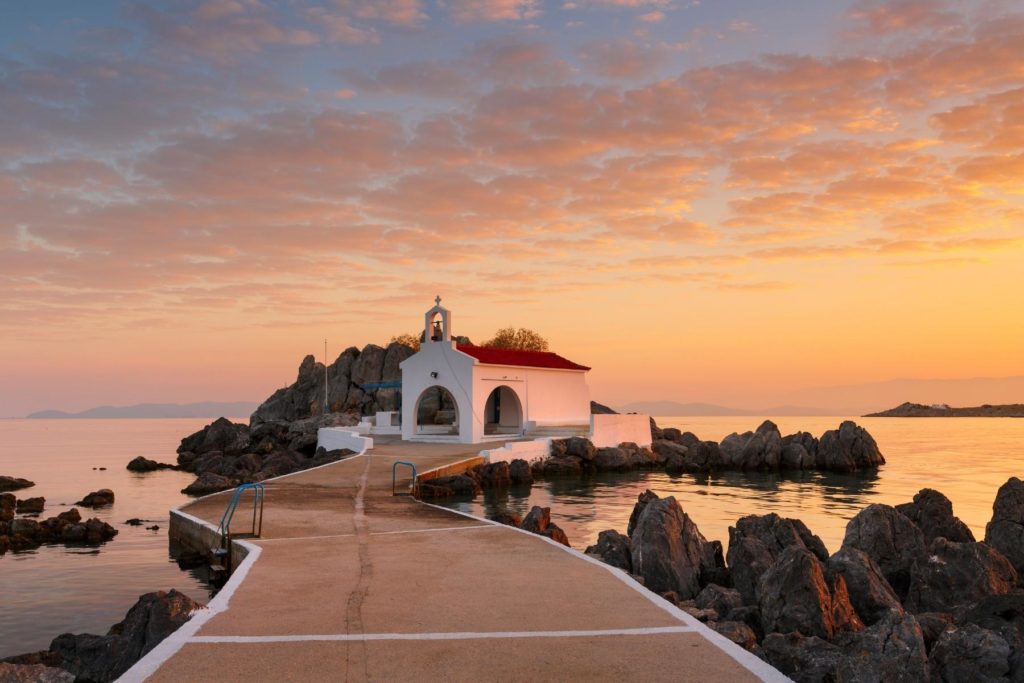
Eventually, the island was conquered by the Turks, who stayed for three centuries. The production of mastic gave the locals some prosperity backed by certain privileges. But the rebellion of 1822 brought with it the great massacre of Chios, where the Turkish navy and army burned villages and towns for two weeks, killing most of the population (over 23,000 were murdered, while another 47,000 were sold into slavery in various parts of the Mediterranean). Only a few locals survived, who rebuilt Chios ten years later. This unfortunate event in the history of Chios was depicted by the great painter Eugène Delacroix in a famous painting (The Massacre of Chios), which is now in the Louvre Museum.
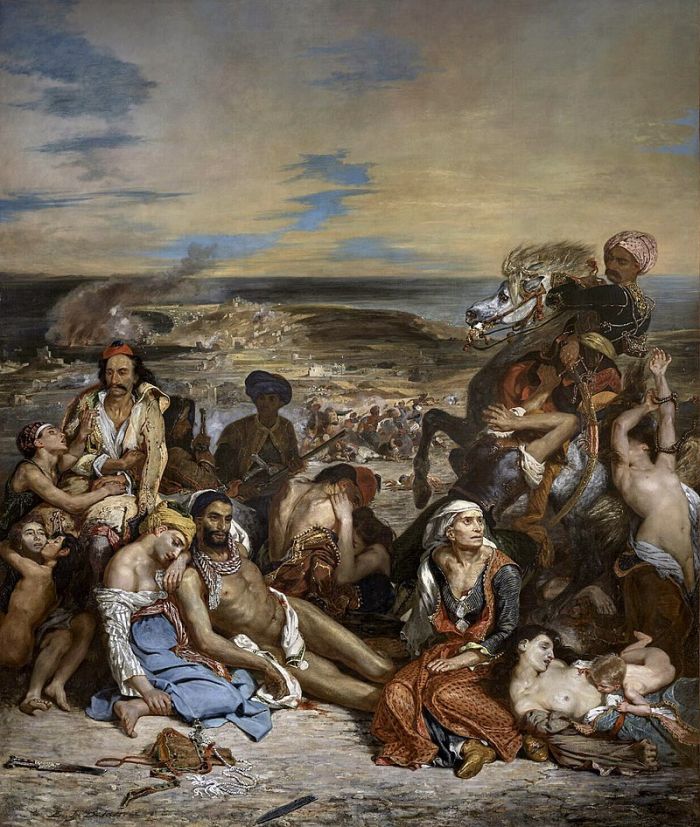
A devastating earthquake in 1881 was to halt the island’s development, however, and it became almost deserted again. In 1912 Chios became part of free Greece, and in the Second World War, the locals held out well against German forces. After the war, Chios slowly began to develop, and today it is an important pillar on the Aegean economic and tourist map.
How to get to Chios
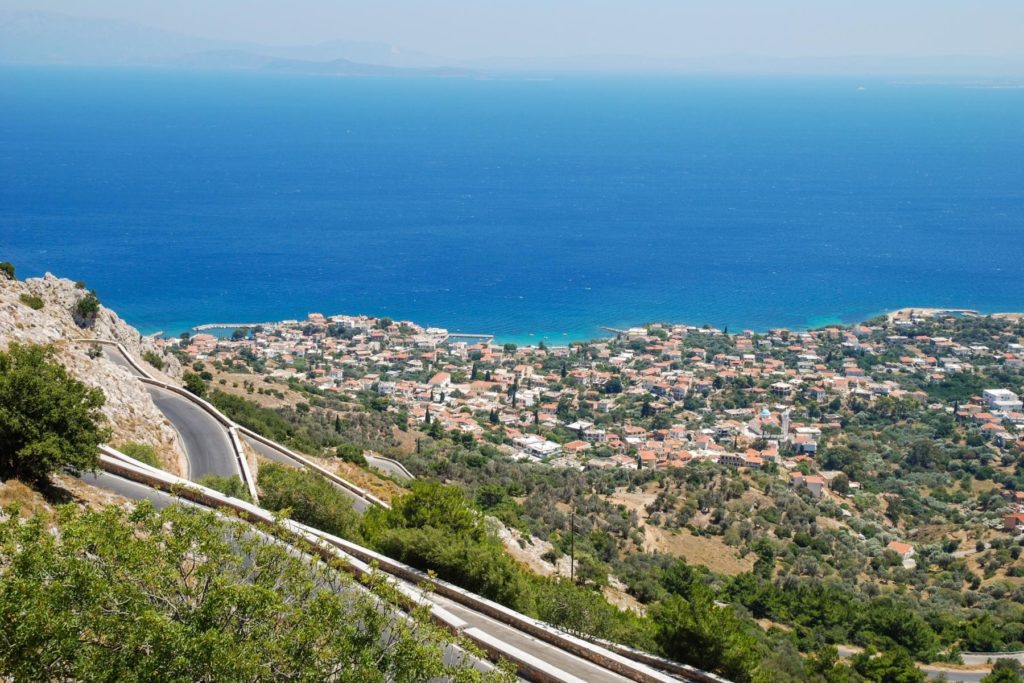
I reached Chios by taking the ferry from the port of Piraeus (about 9 hours), but at the time, I was on a wider tour of Greece. You can arrive in Chios by a travel agency charter or, from two segments, by flying first to Athens, landing at Omiros airport, where flights from Thessaloniki, Lemnos, Lesbos, Rhodos, and Samos also arrive. Therefore the option of flying first to Thessaloniki and then to Chios can also be considered.
By ferry, you can also reach Chios from the islands of Lesbos, Mykonos, Syros, Ikaria, and Samos. Moreover, during the summer, Chios is connected to the port of Kavala in northeast Greece. Another interesting option for those traveling by car is the connection to the Turkish town of Chios, just 15 minutes away by the sea.
Where to stay in Chios
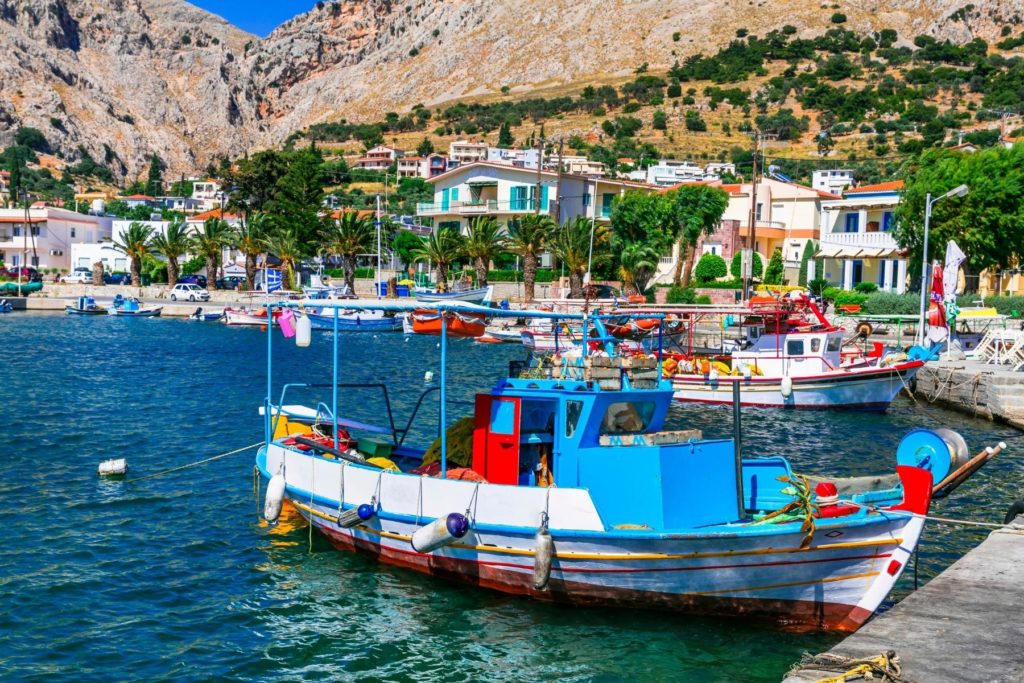
When you decide to holiday in Chios, surely the second question you ask yourself is where to stay in Chios? Which part of the island is the most beautiful? The answer comes from the location of the best hotels in Chios, which are on the beaches around the island’s capital, from Vrontados (in the north) to Agia Ermioni and Karfas (in the south). These places have all the tourist facilities a visitor would need, including easy sea and town access. I always suggest that when you arrive on the island, you rent a car (even for a few days) to drive around and visit the sights of Chios.
So, the eastern part of the island includes the main town, Chios, also known as Chora, in the south of which you can choose to stay – the Kampos area or the Karfas area. If you want an area of wilder natural beauty, head north of the capital (basically the north of the island) to the historic Kardamila and surrounding villages.
The western side of Chios offers fabulous sunsets and easy access to the most secluded beaches and picturesque villages. You can stay in Volissos for a bit of everything, including nightlife in peak season, or choose Mesta for a holiday with a medieval flavor.
Tourist attractions in Chios
Like many Greek islands, Chios is both an open history book and a wonderful beach destination. There aren’t necessarily a huge number of sights in Chios, but there’s certainly plenty to do and see on the mastic island, which offers some extremely interesting places:
Map with the main tourist attractions in Chios and the best beaches in Chios (zoom for details)
Daskalopetra, Homer’s Rock
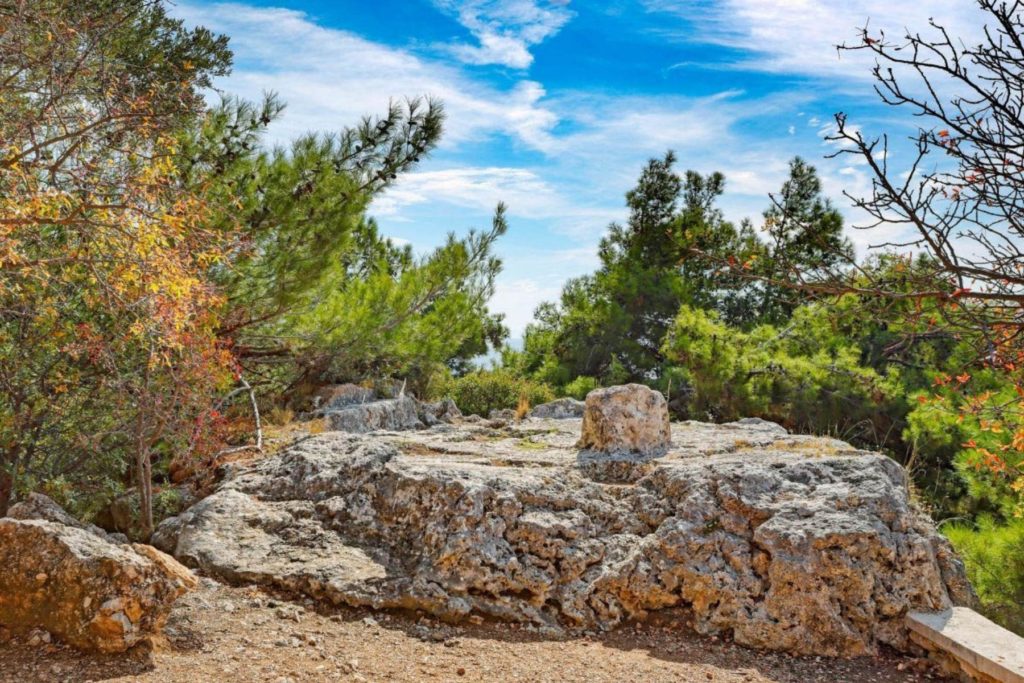
The works of Homer, the father of ancient Greek literature, represent the essence of Greek culture. The Iliad and the Odyssey were taught in schools and are exemplary literary references. Unfortunately, not much is known about Homer’s life. There is much doubt about the place of his birth – no fewer than seven cities compete for guesses, but two stand out in particular: Smyrna and Chios.
Homer was the son of Maeon, of Smyrna, and Crito. His name was Melisigenis, but he was later called Homer (the blind) because he lost his eyesight. He was a bard who roamed all over Greece, telling stories that became true legends. On the eastern shore of Chios, near the villages of Vrontados and Emborio, is an archaeological site identified as the site of Homer’s famous school, the rock in the middle of which is symbolically called ‘Homer’s Rock’ – Daskalopetra.
The caves of Chios
Those who venture into the depths have some rewarding reasons in Chios, thanks to the caves that dot the island and can be alternatives to explore on extremely hot days.
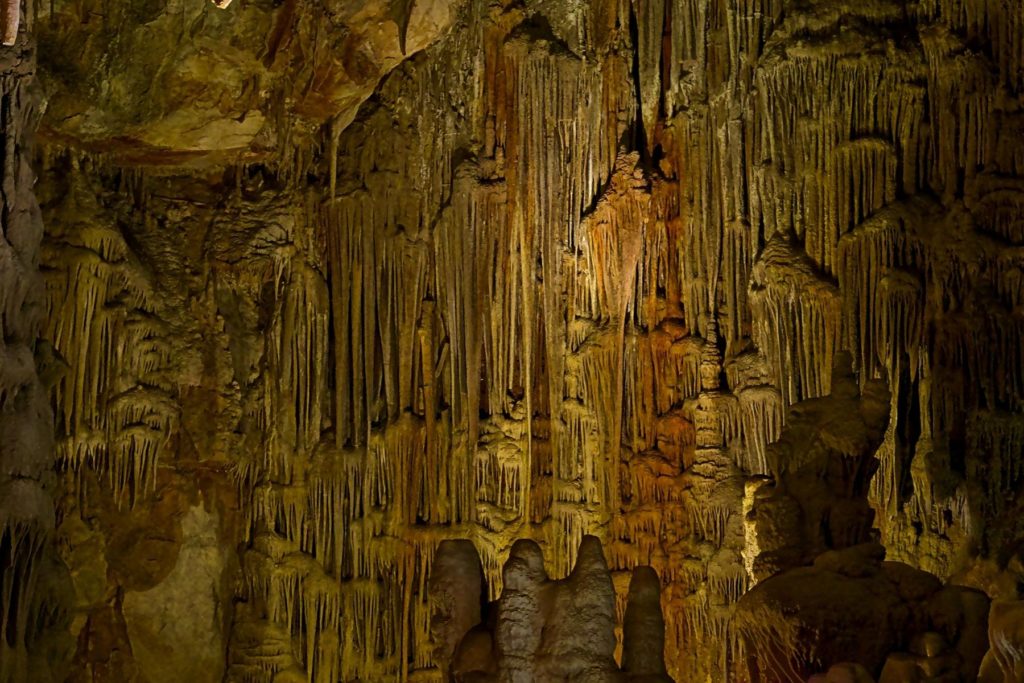
Olympi Cave is located near the medieval villages of Pyrgi and Mesta, on the island’s southern side, and is set 100 meters above the sea. It is a rather small cave, but it has very beautiful stalagmites and stalactites, the interesting part being that some stalactites are active in the process of forming. Moreover, some are creating horizontally, which is extremely rare. This cave is open to visitors from May to November, every day of the week (except Mondays) between 11 am and 6 pm.
You can also visit Agio Galas’s caves, an hour northwest of Volissos. Here you’ll also discover an exciting museum by a river, as well as caves that are home to several small churches. One of these is said to have the milk of the Virgin Mary dripping from its walls.
Nea Moni Monastery
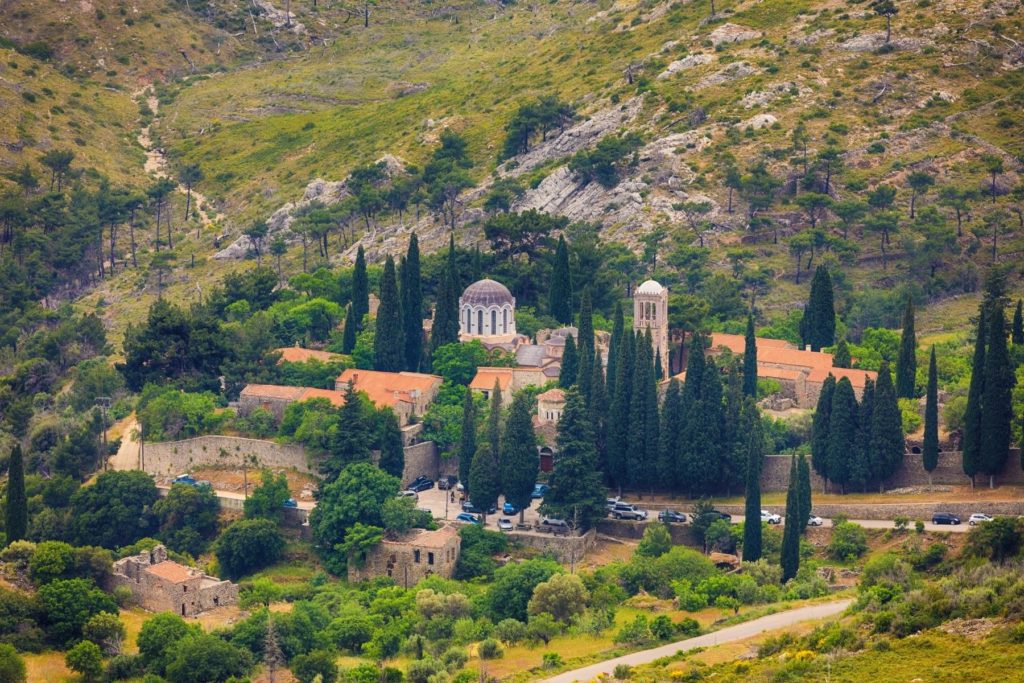
For both fans of ecumenical tourism and those who don’t worship at every turn but appreciate valuable historical monuments, the Nea Moni Monastery is a must-visit in Chios, if only for the simple fact that it is one of the oldest places of worship in Greece.
It was originally built in the 11th century (1042-1055) by order of the Byzantine Emperor Constantine IX Monomachos and his wife, Empress Zoe, on the site where three monks found a holy icon of the Virgin Mary. In the 17th century, the monastery had a population of about 800 monks, but after the Ottomans destroyed Chios in 1822, the number significantly decreased.
Only the conventual church, the cistern, the tower, part of the refectory, and the church of Agios Loukas in the monastery cemetery outside the wall survive from the original complex. Renowned especially for the frescoes on the church walls, Nea Moni Monastery (where only three monks now live) was included in the UNESCO World Heritage List in 1990.
The mastic villages of Chios
The southern plains of the island of Chios are among the few places in the world where the mastic tree does excellently, producing a resin with a special composition known as mastic. There is even a legend about mastic. It is said that around 250 AD, the Roman authorities of Chios issued a bounty on the head of a Christian, Saint Isidor, the spiritual patron of the island. One day, the Roman soldiers managed to identify him and began to pursue him throughout the region south of Chios. In desperation, the saint asked Jesus for help. Miraculously, a white horse appeared; Isidor climbed on it and escaped the pursuers.
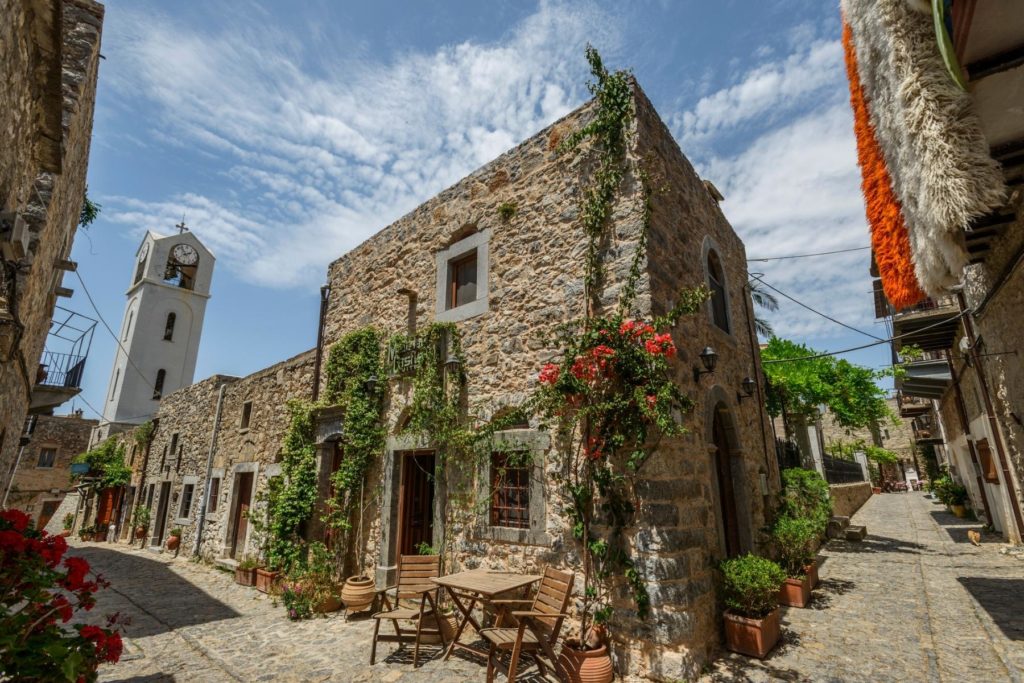
Near the village of Mesta, the saint decided to rest under a mastic tree. As he lay under it, the tree began to pour sap from its trunk as if shedding tears that healed St Isidor’s wounds.
Residents of villages south of Chios have been growing mastic trees since Roman times to collect their valuable resin. More than 20 villages in the area twinned and began large-scale production. So intensive was this production that no farmer had the right to abandon his fields without permission. These villages thus entered into a kind of self-isolation that lasted until the 19th century, leading to the formation of different customs and even dialects in the area known as Mastichochoria.
In ancient times, mastic was known for its medicinal properties, and in ancient Egypt, it was used in the mummification process. In the eastern Mediterranean, it is used both as a medicine, in cooking, and in producing an alcoholic drink. Various cuisines in regions belonging to Greece, Turkey, Egypt, and the Middle East have recipes using mastic, especially in preparing desserts.
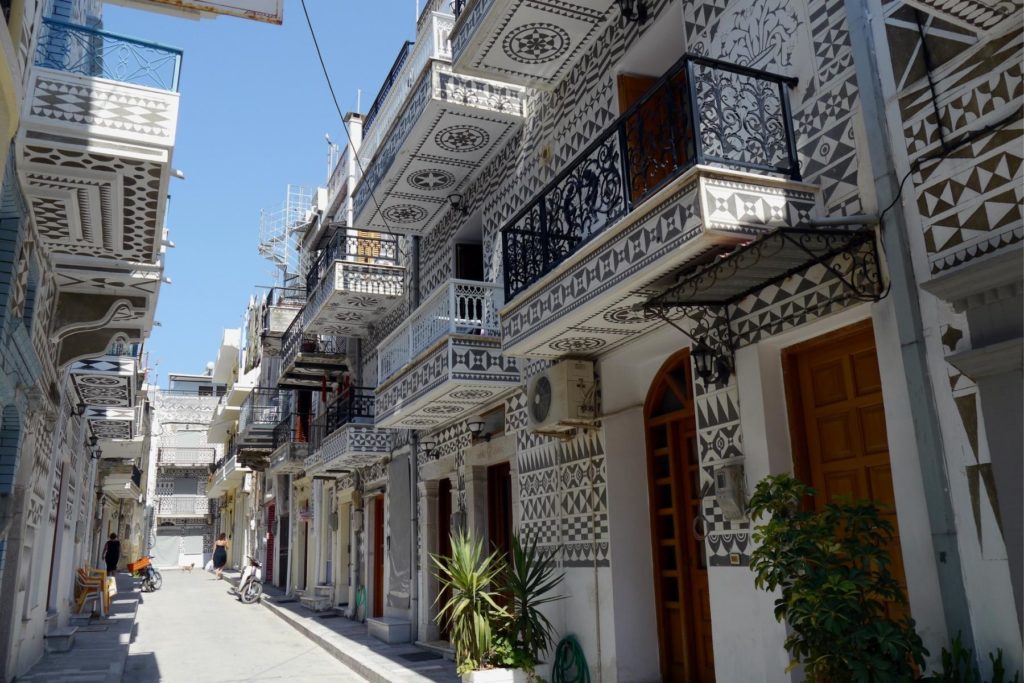
So if you end up in the southern part of Chios, experience the authentic medieval atmosphere of the mastic villages. There are no less than 24 of them, including Armolia, Pyrgi, Mavra Volia, Olympoi, Mesta, Kalamoti, and Katarraktis, one more beautiful than the other.
Pyrgi, for example, is a unique village (one of the few not destroyed by the powerful earthquake of 1881), with a geometric black and white decoration on the outer walls of the houses, narrow streets, and numerous churches, including the Byzantine Church of the Holy Apostles, built in the 13th century. In addition, the locals are renowned dancers who love to wear their traditional costumes on every special occasion, so if you’re lucky enough to stumble upon them during a festival, you’re in for a unique show. Pyrgi even has a Mastic Museum.
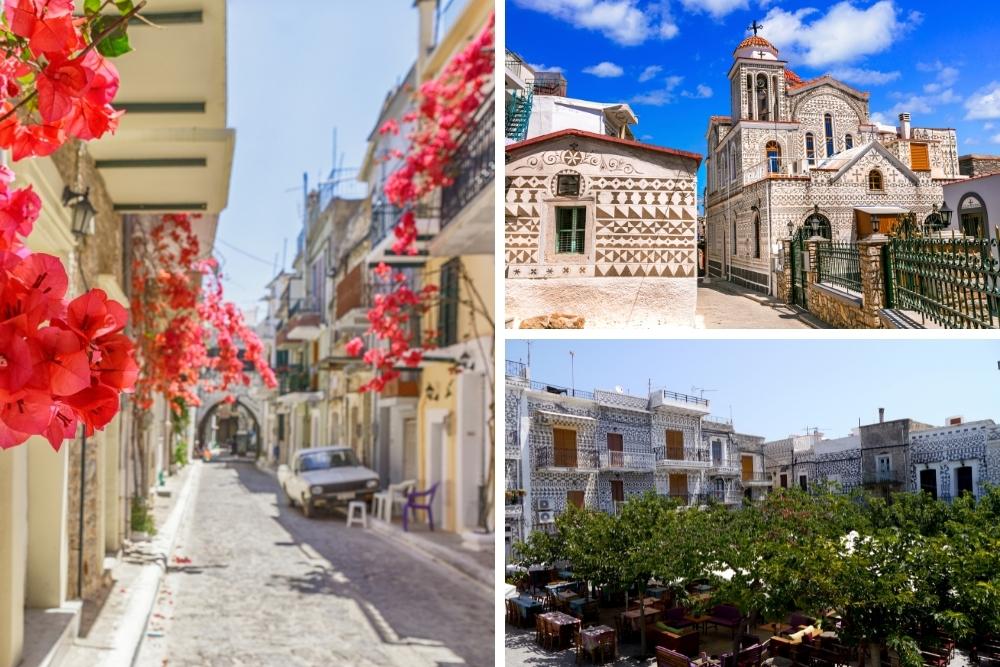
And the people of Armolia have a long tradition of making and decorating pottery – jugs, vases, jars, bowls, and cups – so there’s a wonderful collection of local pottery, and you can still see potters in the village working clay by hand in the traditional way.
The medieval castle of Chios
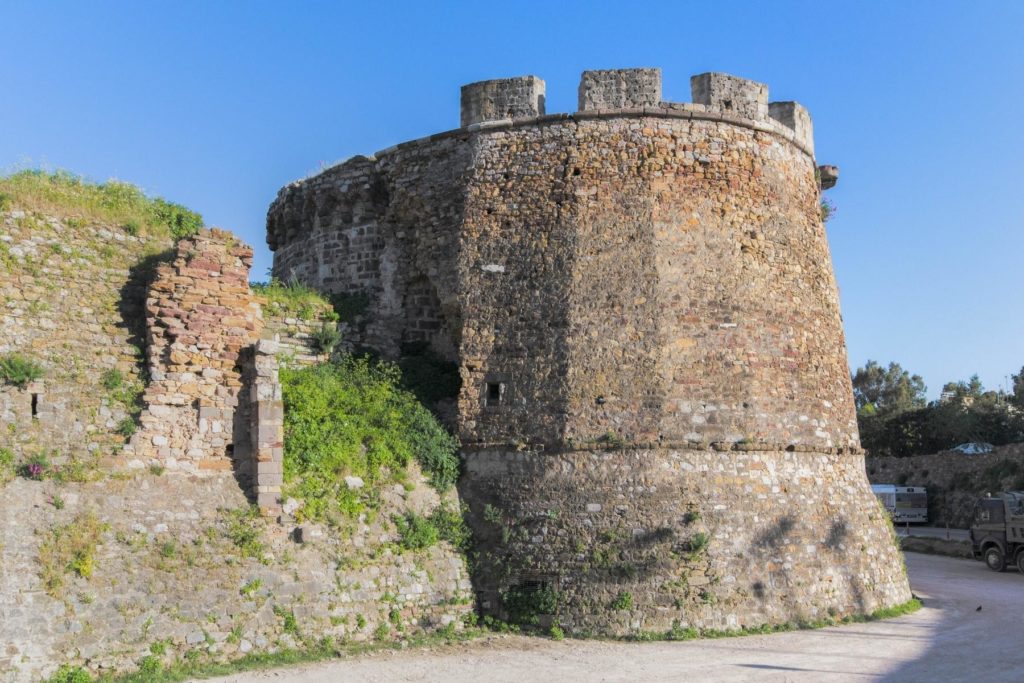
Originally, the town of Chios lay exclusively within the walls of this castle, whose construction began in the late 10th century. The Venetians rebuilt the Central Gate in 1694, the main entrance gate to the castle on the southern side, but the original building was knocked down – almost nothing survived, so the castle was rebuilt over time in the 14th-16th centuries.
The Ioustiniani Palace (with its two floors), the Kria Vrisi (Cold Fountain), the semi-subterranean water cistern (built by the Genoese), and the massive Kulas Tower are the main features of the castle, which can still be visited. Interestingly, the fortress is now inhabited by residents, allowing you to feel the vibe of an actual medieval settlement.
Volissos Castle
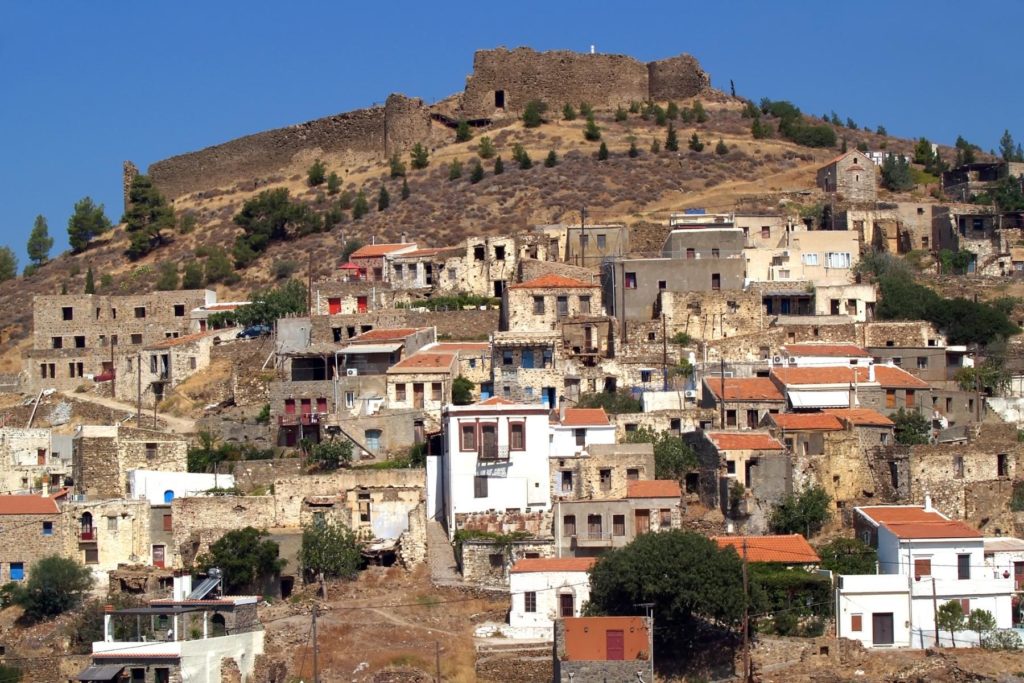
Located in the northwest of Chios, just above the village of the same name, Volissos Castle is built on the site of the ancient village of Voliskos, where the poet Homer is said to have lived. The castle was originally built by the Byzantines, most likely around the 11th century. In her historical writing, Aleksiada, the Byzantine princess Anna Komnini refers to this castle. In the 15th century, Volissos was rebuilt by the Genovese, this being its final (and current) form; the main purpose of the castle was to protect the north-western parts of the island. Visitors today enjoy the beautiful view of the Volissos castle at an altitude of 230 meters, especially at night when it is illuminated.
Kambos
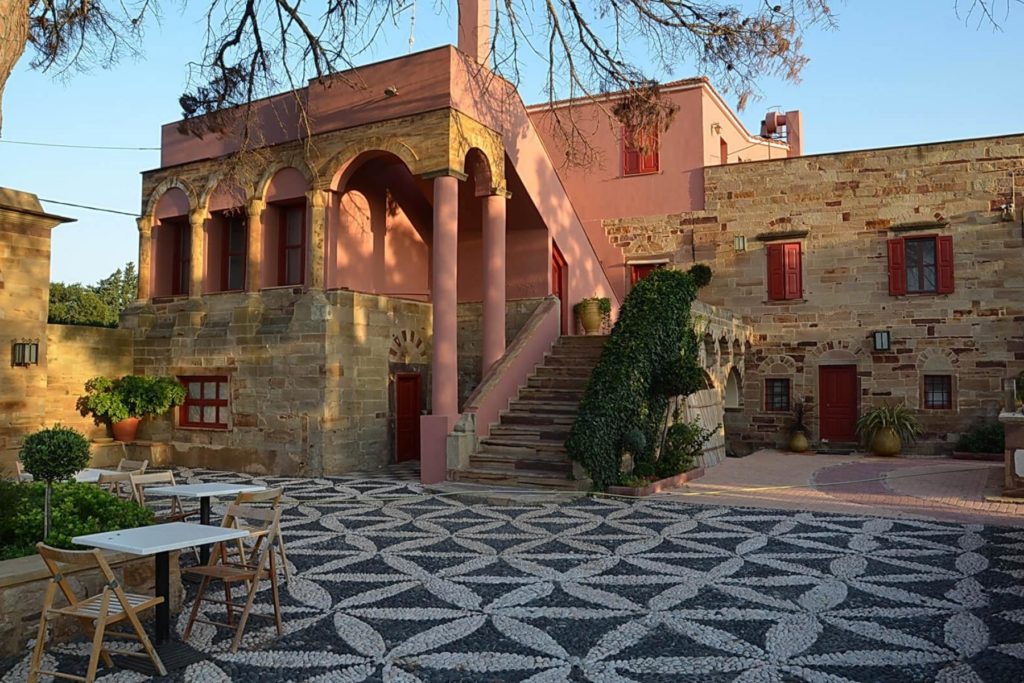
The town of Kambos is located in the southern part of the island and attracted many Genovese nobles several hundred years ago. In their wake, luxurious mansions and mansions remain here, which you can see practically every turn. Many of them are now home to hotels and restaurants, and each villa is surrounded by a lush garden with exotic plants, making a walk through Kambos a very pleasant and relaxing activity.
Chios Town
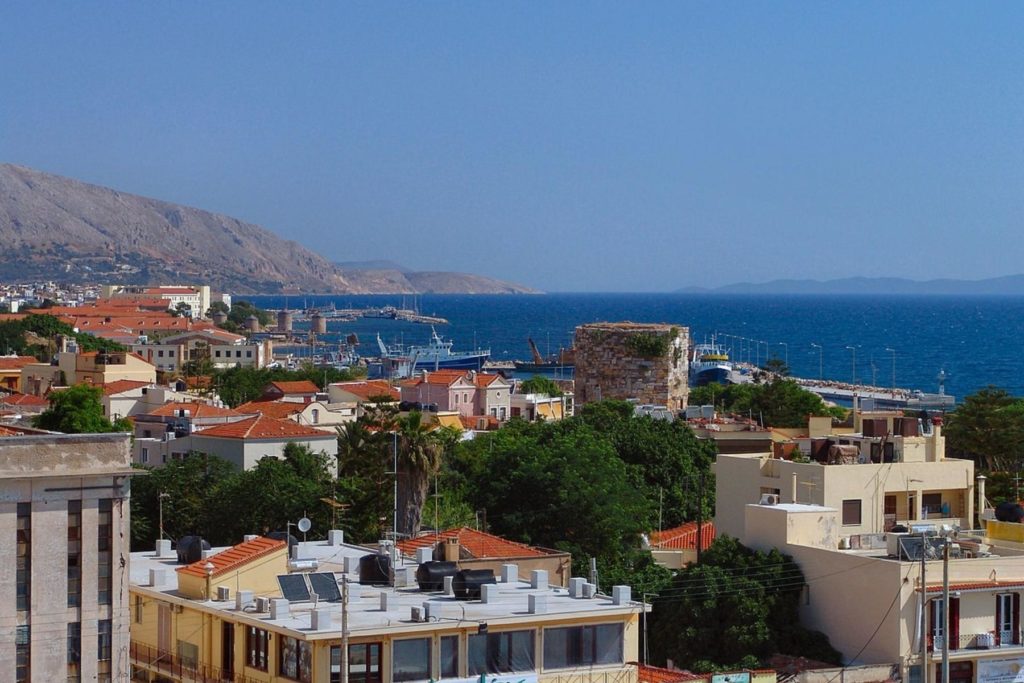
The capital city of Chios (or Chora) is mainly known for its many attractive museums. Here you can visit the Argenti Museum and the Korai Library, which house a rich collection of national costumes and paintings, the Byzantine Museum (with an interesting exhibition of ancient icons and sculptures), the Archaeological Museum (with extensive collections of archaeology discovered in various historical eras), the Maritime Museum (with exhibitions demonstrating the vital role that the island of Chios played in the development of maritime transport in the 20th century, practically inaugurating the ‘golden age’ of Greek post-war shipping).
The central square of Chios is called Vounaki Square. Here are the administrative buildings of the North Aegean Municipality and Prefecture, the Ottoman mosque of Mezitie (where the Byzantine Museum is located), and the municipal garden. Near the central square, remnants of the Ottoman occupation can be found in the Bairakli Mosque, the Osmanie Mosque, and the Ottoman fountains. In the wider area, you can visit two ancient temples: the deserted temple of Agios Vasilios (St. Basil) and that of Agios Georgios (St. George).
Kennedy Street leads to the imposant main gate of the medieval castle of Chios
The most beautiful beaches of Chios
The island of Chios has numerous beaches along its coasts – over 80! Clean waters bathe them, most of them set in very pleasant natural settings. Mavra Volia Emporios and Karfas are the most famous beaches on Chios, and they are fully equipped with tourist facilities. But if you prefer a secluded, unorganized, but very quiet beach, take a drive around the island, and you’re sure to find what you’re looking for. There are around 30 beautiful bays on Chios, large and small, with beaches that are just waiting for visitors.
Mavra Volia Beach
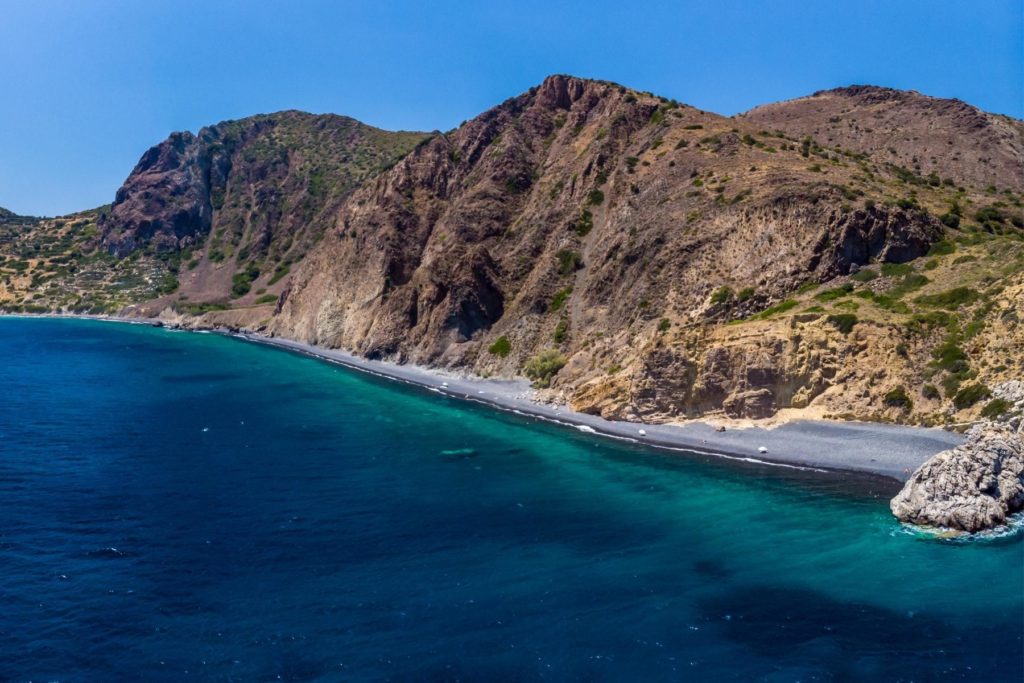
Mavra Volia, one of the most famous beaches in the whole of Greece (in 2017, it was nominated as the most beautiful beach in the country), is located about 30 km south of Chios town and 5 km south of Emporios. Its identity element is its shiny pitch-black pebbles, the result of the eruption of the now inactive Psaronas volcano.
Also known as the ‘black sea shore’, Mavra Volia is famous for its dark, deep, and usually cold waters. It is bordered by high cliffs, which give the landscape a dramatic air. Two individual beaches distinguish it, the northern one being called Foki beach.
Those who want to visit or even stay overnight in this special corner of Chios find a wide variety of restaurants and accommodation in the nearby village of Emporios.
Karfas Beach
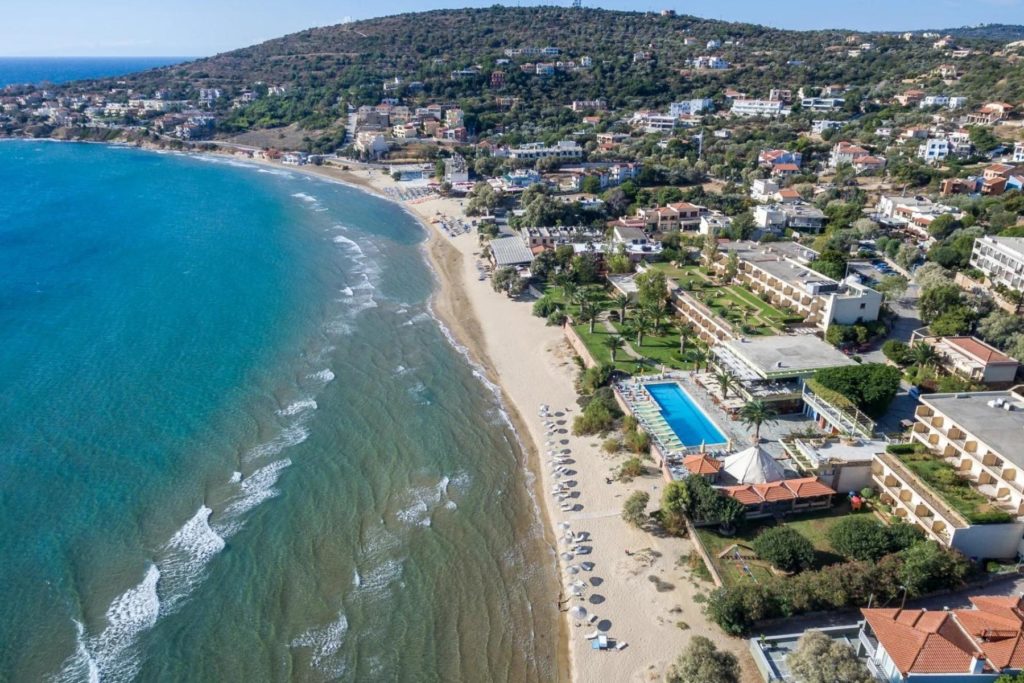
Karfas Beach is located 5 km south of Chios town, in front of the seaside settlement of the same name, which is also the island’s biggest tourist resort, welcoming many visitors every summer. The beach has fine sand and clean waters and offers all the necessary tourist facilities – sun loungers, umbrellas, and water sports equipment for hire. Around the beach are hotels and accommodation of all kinds, as well as bars, cafes, nightclubs, and restaurants.
Didima Beach
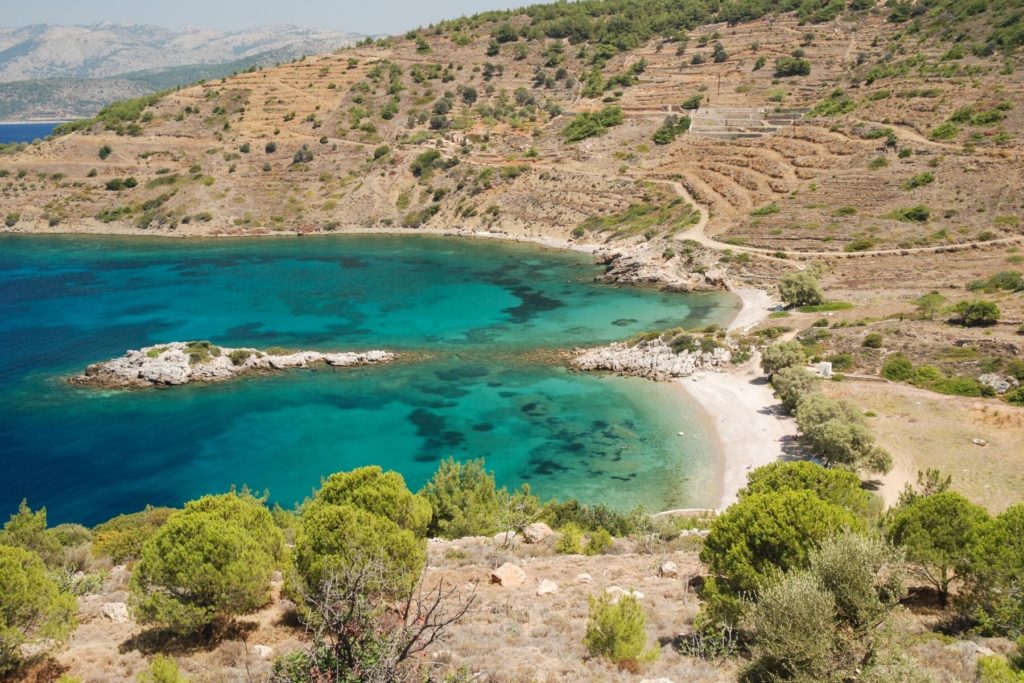
Didima Beach (Greek for “twins”) consists of two small coves near the charming village of Mesta. It is located 32 km south-west of Chios town, away from the crowded coasts of the island’s center. The coves with white pebbles and crystal-clear waters are very similar.
The beach is completely unspoiled and secluded, with steep cliffs surrounded by natural scenery. The water quality and private atmosphere captivate visitors. You will not find tourist facilities near this beach which is hard to reach by public transport; therefore you have to come here by car.
Glari Beach
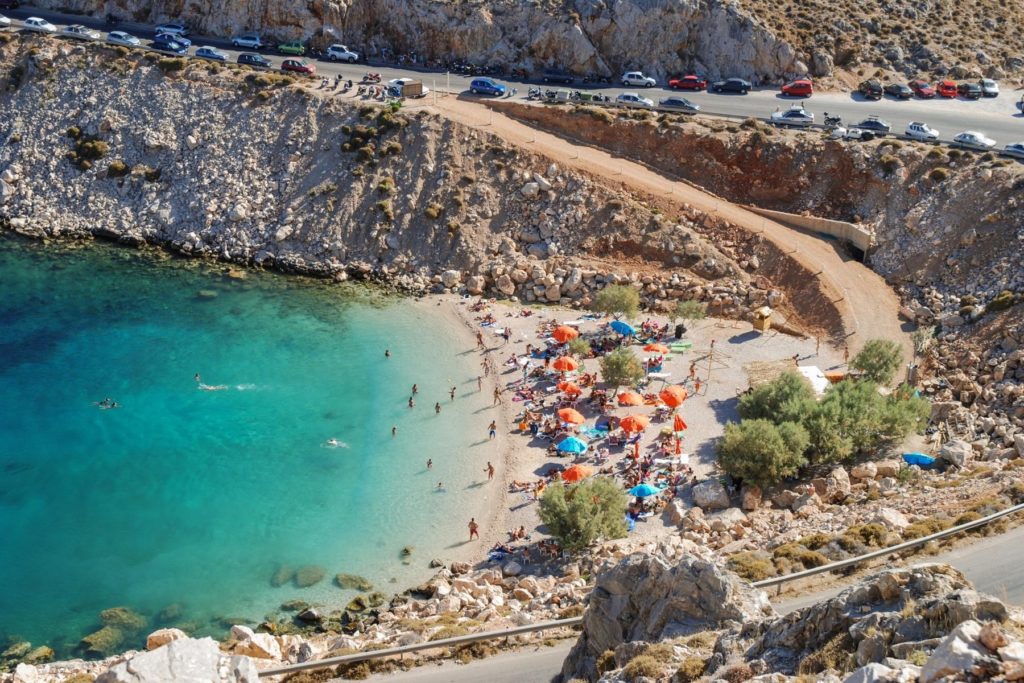
Glari Beach (“Albatros”), one of the most cosmopolitan sandy beaches in Chios, is located about 9 km northeast of the capital, between the Vrontados area and the village of Sikiada, on the road to the village of Kardamila. In the past, there was a quarry here, and mining activities were thriving.
When human activity ceased, the waves of the sea took over. They began to patiently batter this beautiful bay, characterized by crystal clear, blue and green waters, which are particularly cold, mainly because of the spring that comes from the mountain and flows directly into the sea in a wild landscape. In winter, albatrosses nest here, hence the name of the beach.
Agia Fotini Beach
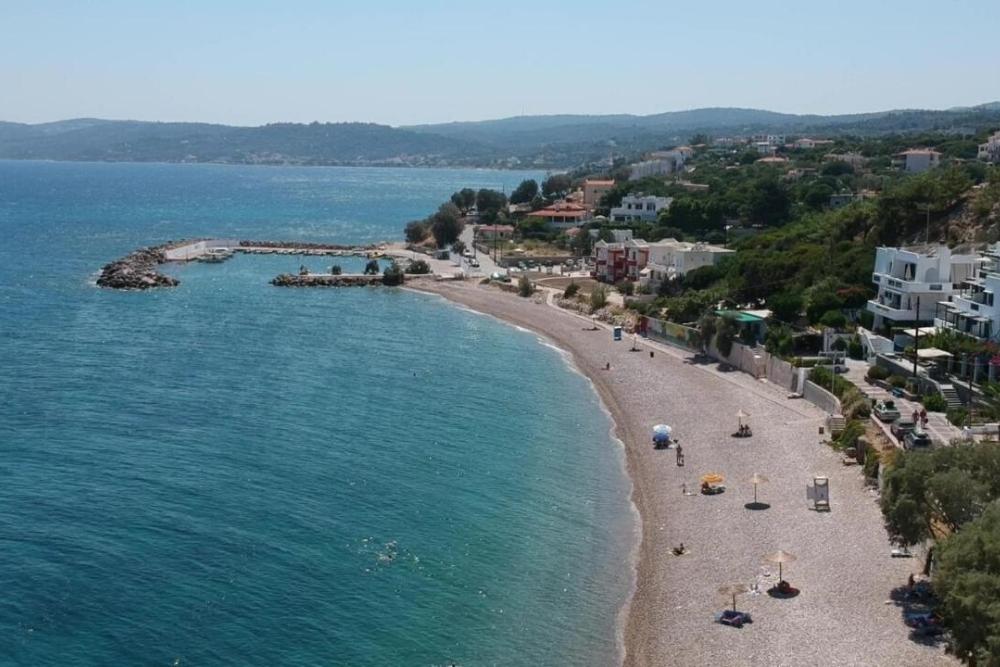
Agia Fotini is a beautiful coastal settlement, 15 km south of the town of Chios, which has one of the most beautiful beaches on the island, situated in a bay with a pebbly shore and crystal clear waters. The surroundings benefit from extensive greenery and offer moments of relaxation and leisure.
The beach is partly laid out with umbrellas and sun loungers. The eponymous coastal settlement nearby is very well developed from a tourist point of view, which is why you can find taverns and all types of accommodation here. It’s an ideal place to spend a few days in a quiet area with easy access to many sights.
Trahili Beach
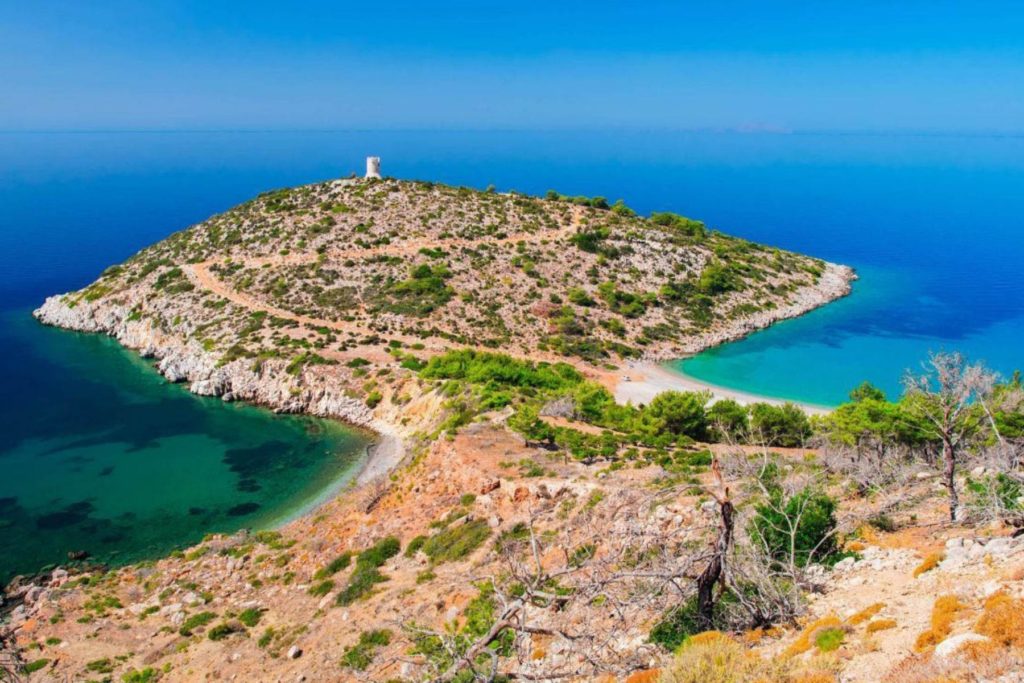
Trahili is another beach in Chios, with pebbles and blue-green waters, located 21 km west of the capital, near the village of Avgonima. This beach caters to those in the mood for deserted beaches with clear waters and no facilities. A narrow strip of land leads to a small island that hosts one of the most spectacular viglas on the island of Chios (medieval watchtowers used for timely warning of pirate raids).
Megas Limnionas Beach
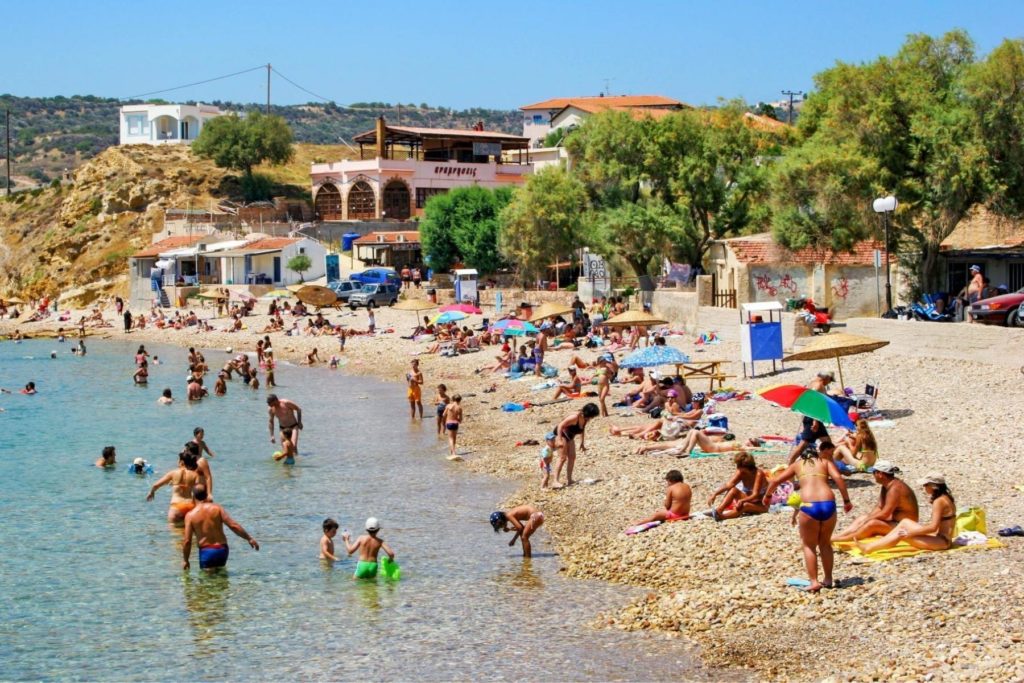
Just 15km south of Chios town, you’ll come across the charming Megas Limnionas beach; a small shoreline made up of pebbles and sand. It’s a popular spot for families with children, thanks to its shallow, crystal clear waters. As an important tourist resort, Megas Limnionas offers a wide range of hotels, studios, and rooms for rent. There are also many delicious fish and seafood tavernas.
Gastronomy in Chios
Like most Greek islands, Chios has developed Mediterranean gastronomy, customizing its dishes in its own style, also influenced by the culture of those who have lived here over the centuries. The suggestion is the same: avoid any easy gastronomic tourist traps and seek to eat in traditional tavernas, where the locals usually come to eat.
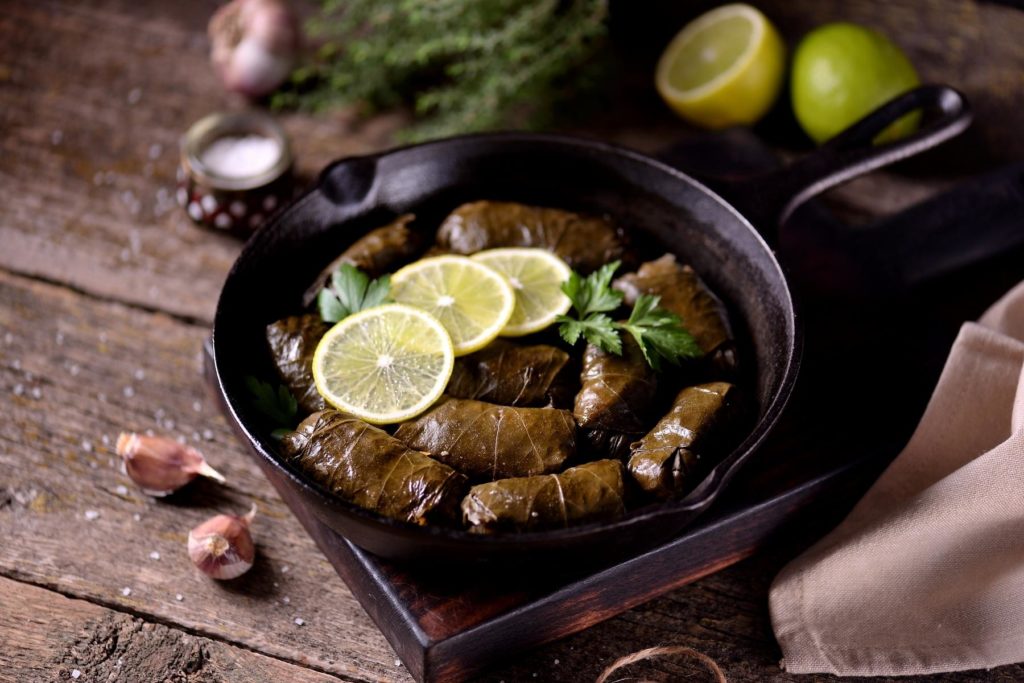
As well as Greek horiatiki salad, souvlaki, gyros, moussaka, and lamb chops, plus seafood and fish dishes – classics for island Greece – real foodies can experiment further, for tefteli and dolma (vine leaves stuffed with meat), stifado (made from stewed meat), kokoretsi (a kind of lamb stew) and loukanika (tasty local sausages).
Don’t forget the soups either: kotosoupa is a classic chicken soup with egg yolks and lemon juice (called avgolemono) , fasolada is white bean soup, and kakavia is a traditional fish soup.

Vasilopita is a traditional dessert, a cake with lemon and flavored herbs, Keik me giaourti is a honey and yogurt cake, galaktoboureko is a traditional Greek pie, and mandolato is an almond gingerbread – so as you can see, Chios isn’t bad at desserts either.
In the end, of course, don’t forget to try a glass of mastika because a visit to Chios would not be complete without this spirit. Mastika is usually served as a digestive, with almond desserts or after a meal, and its aroma is somewhat similar to licorice.

In conclusion, the island of Chios has everything from ancient temples and abandoned fortified settlements to medieval castles, beautiful beaches, and flavored mastic villages! Discover the most beautiful tourist attractions in Chios by choosing a holiday on this special island where you will most likely want to return.
You may also like: Tourist attractions in Evia. What to do and see on Greece’s second largest island




